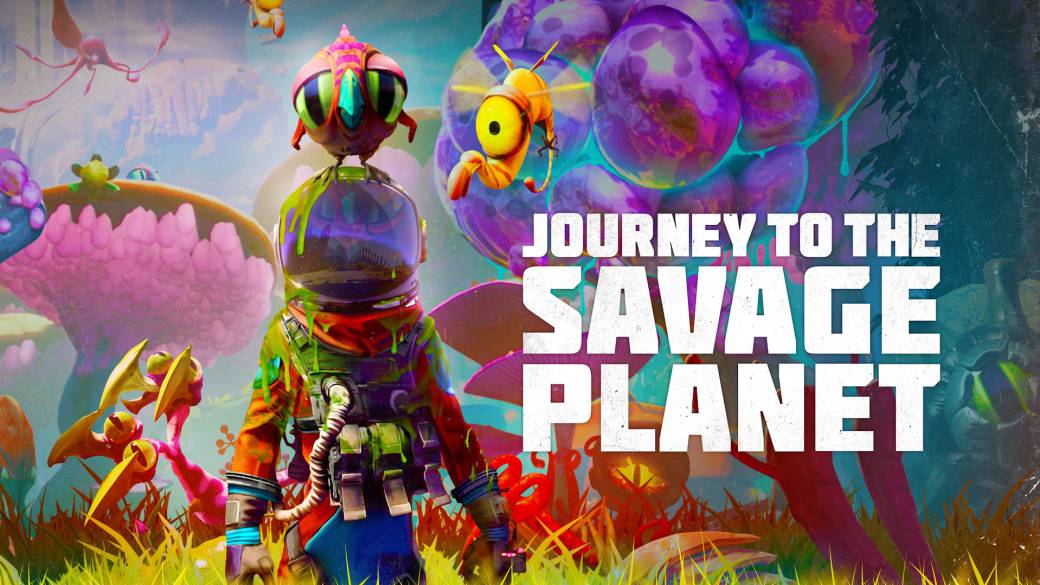
Typhoon Studios premieres with a crazy genre cocktail. Join Kindred Aerospace and jump into the adventure! (Security not guaranteed)
Among the strange creatures that we find shortly after setting foot in AR-Y 26, the wild planet that gives its name to the game, it is hard not to highlight the Babushka. Species of medium-sized terrestrial bird, with two elongated necks that flow into its own pair of heads, panics when it detects us and begins to run while emitting comic screams, almost like a cartoon. When scanning it to incorporate it into our database, E.K.O., the art intelligence that accompanies and advises us, exclaims a “He thinks you are going to kill him! Ohhh, how right ”with the most condescending tone possible. So we shot him – for science – but the Babushka does not die. Instead it is divided into two other creatures, smaller and of different color, with a neck that at its end is still two-headed.
The screams intensify and surround us. The tone of EKO is no longer as jocular as before. “Now he's twice as annoying! But shoot him! Please! ”We barely managed to hit one of them, since these new versions move faster. And surprise, it is divided again. This time the result is creatures with a neck and a head, but they escape before we can scan them for the third time. The screams go out in the distance, returning the prominence to environmental effects and ending an encounter that still has us confused. But tranquility is ephemeral, and as they prowl in search of another objective, the shrieks emerge and reveal their position. So we follow our ears and take the mini Babushkas out of their misery. The prize is a bit of peace, resources that we will use later to build some improvement on the Javelin (our ship) and the certainty that Journey to the Savage Planet is not going to be the typical exploration and farming game.
Kindred Aerospace: not the best, but the craziest
This kind of irreverence permeates the debut and, in a stroke of irony, also goodbye to Typhoon Studios as an independent studio (weeks ago it was acquired by Google to work at Stadia, although Savage Planet remains multiplatform and comes from the hand of 505 Games ). Team founded by creatives that once swelled the ranks of companies such as Ubisoft or Electronic Arts, often boasts the kind of design one would expect from experienced developers, but also an almost aggressive need to demonstrate how frivolous this twist is to some familiar topics and mechanics of the medium. What does not act to the detriment of the title, but rather the opposite, because this attitude works like the glue that unites all its parts.
Even if it is not the biggest fan of that childish humor in which it borders when we collect the “carbon” fragments expelled by the back rooms of a freshly fed animal, the license is part of a delusional hyper-reality that begins to be built with the endearing psychopathy of an EKO with traces of GLaDOS and reaches its greatest peaks in the retransmissions that we can see from Javelin. Savage Planet is light in argument, but the messages pre-recorded by Martin Tweed, CEO and visible face of Kindred Aerospace – fourth best space exploration company! – never fail to remind us that whatever the doubts we have about our mission on this inhospitable planet, our contractor is even more lost than us.

These sequences, renewed as we progress to create some narrative inertia, are also seasoned by even more hilarious commercial nature (a pet made from meat waste, a MOBA that promises to merge with microtransactions) or occasional dedicated emails to outline a surreal world that we may not see in the first person, but we do perceive in a crystalline way during our distant and lonely adventure in space. Of course, that "lonely" is treatable, since another person can join the exploration thanks to an online cooperative mode. But both plot and playable, the development is clearly designed with a player in mind.
Can we keep citing Dark Souls this decade?
When trying to explain Savage Planet to someone without experience in it, it is almost impossible not to resort to other games. But not only because they function as a shortcut, but because Typhoon Studios also does not hide its influences, it is put on as medals that it later deconstructs while winking at a player as surprised as the proverbial Babushka. So if you don't like the comic abuse of Dark Souls to fill lines, we have bad news. Although Savage Planet is not a gloomy or particularly difficult game, you will die. But, really. And the materials collected since the last visit to the ship will remain in the body. Luckily, Kindred has contingency plans and creates clones to fix those messy while EKO jokes about the fact that we are no longer us, but someone else.
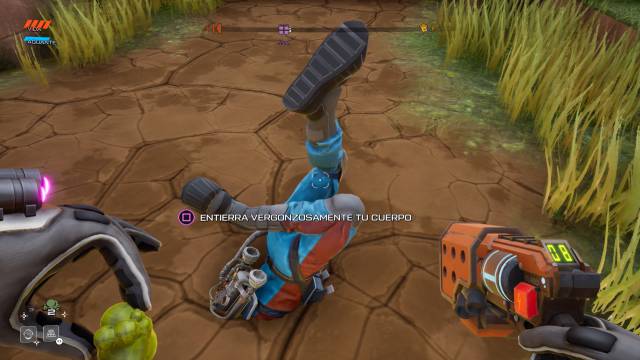
On a superficial level, however, a more obvious similarity is probably with No Man's Sky. Savage Planet does not have a procedural universe that extends to infinity and beyond, everything in your world has been placed manually and intentionally. But both the pleasant alien aesthetic, full of creatures of great personality and imaginative scenarios bathed in vibrant colors that counteract the possible technical limitations of the project (it is easy to forget that the team does not even reach thirty people), as the need to accumulate a series of materials to improve the capabilities of the weapon or suit, evoke a more focused-and concentrated-version of the Hello Games game.
A significant sample of this is found in the alien alloy. While the other elements (carbon, aluminum and silica) can accumulate by killing indigenous creatures, breaking mineral veins or other methods that we discover on the fly, the alloys sprout from special, limited flowers that do not regenerate. Sometimes they are already open and ready to pick up, since the goal is simply to reach them – by being located inside caves or hard-to-reach places, for example. Others, however, we must look around to find out if they are closed by the presence of enemies that control by spores – extraterrestrial biology, do not ask – or if they leave large roots that move away to hide some bulbous yellow ends that we must find and destroy Either case evidences that more thorough design, which requires attention and often also a use of the equipment beyond the gun.
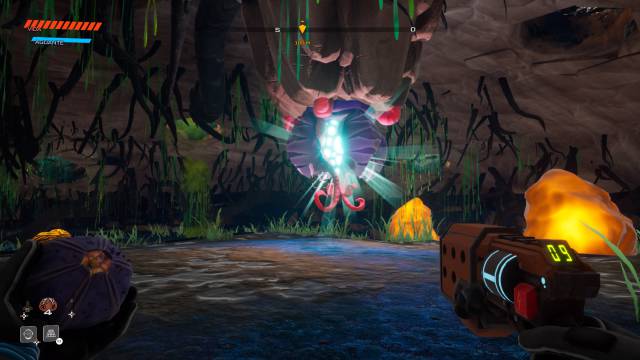
Putting Prime in Metroidvania
This is a good time to reintroduce the notion of the scanner and open the door to another of its clearest inspirations: Metroid Prime. Although Savage Planet has an action component, it is lightened to favor contextual logic around flowers, fighting and other situations raised more in puzzle terms than mechanical skill tests. Most of the creatures of AR-Y 26 are peaceful and explode in pristine puddles with resources if we shoot them or kick them – surprise !, the human is the villain -, but as we explore the planet we acquire other supplementary tools which add variety and encourage experimentation in and out of fights. Unlike the gun, whose ammunition is infinite, the use of the remaining equipment is limited by its collection and encompasses functions as varied as bait, explosives or corrosive acid.
To understand and familiarize ourselves with these possibilities, a special viewer comes into play that allows us to focus on a multitude of structures, flora or of course fauna to gather information, always screened through the humor of EKO – both for its spontaneous comments and for the more detailed descriptions which then fill the discarding database. As in the saga of Retro Studios, on occasion, the scan itself activates mechanisms, but usually fulfills a narrative and didactic purpose. If shooting the bulge does not work to solve a situation – and as the hours go by, it does less and less -, the scanner is the best way to know if we need to look for a nearby item on the stage, use a certain tool or come back later with a skill that, as in every good metroidvania, has not yet been put within our reach.
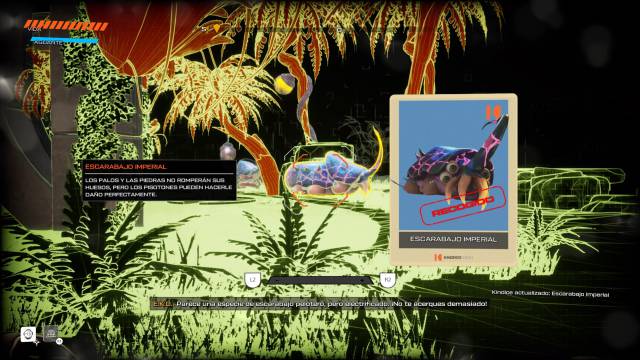
That said it might seem that the viewer eliminates steps of the deductive process, and in a way does. In addition, it works in tandem with a compass and some markers that lead us to the key points of both the main mission and some secondary ones if we want to. But this – and EKO itself -, beyond being optional and / or deactivated via the menu, serves to lighten a pace where it soon becomes clear that the goal of Typhoon Studios is not so much to pose an intellectual or mnemonic challenge as to create an interesting world to explore. Where even the shortest game session offers something new, be it an area, an enemy, a skill or an object. Savage Planet does not take in establishing a loop of constant acquisition and essay that leaves in our hands the possibility of shaping the experience away from the indicated route or using a pinch of lateral thinking.
This is well seen in a fight that explains the fundamentals, but then lets the player discover on his own that perhaps it is not as limited as it might seem in the initial contact. That doing feints and aiming at weak points with such a basic weapon (we can expand damage and capacity, in addition to getting a loaded shot, but stick to that), without the characteristic centering of Metroid Prime, is perhaps not the best strategy. That is where it comes to remember, for example, the specifics of the fixative gall (creates catchy traps), the shock fruit (emits electric shocks when it scares it), or perhaps even a contextual demolition action that appears when catching a certain creature that block the entrance to one of the first caverns. Although the game never climbs too much in difficulty, it does enough to give value to that maxim that is better than strength.
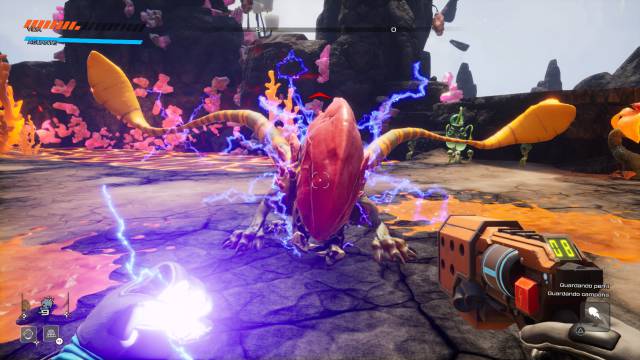
Banjo-Laylee and Daxter 64: First Person Edition
Interestingly, when it comes to exploration we have to get out of Prime's shadow and find even more influences. Because the procedure of chaining classic improvements such as the double jump or the hook to progress itself is pure Metroid – and welcome because it is not even a formula so exploited in the three dimensions as in the side of the lateral scroll. But when commenting on the design of levels it helps us to go back even further and remember not so much specific games, but a whole subgenre in relative disuse: the collectathon. In case someone is not familiar with the term, less frequent than metroidvania, it is used to catalog a certain kind of platforms quite predominant in the first years of 3D development, where wide, but not too much (proto-sandbox) worlds were used, segmented by thematic blocks, as a rule quite compact and with multiple simultaneous objectives in which to get involved.
It goes without saying that part of this still overlaps to some extent with Prime, but Savage Planet opens the structure more – although the overall size is smaller – and even dispenses with the map. In addition to the aforementioned compass, the license is due to the lower proliferation of tunnels or labyrinths, to a design that often allows the horizon to be sufficient to be oriented, to a strong use of colors, vegetation and orography to enhance the identity of each zone, and also to a convenient teleport system to travel in seconds between any of them. Even when the final stretch arrives and the game proposes its version of Chozo Artifacts – MacGuffins scattered all over the world – we can complete the search in a plis plas thanks to its agile navigation and the help of some optional improvements.
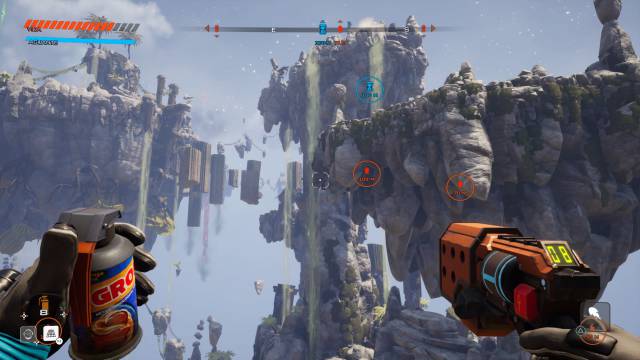
And it is that although there is a sequence of necessary unlocks to progress in the direction towards credits, that which we usually define as the main development, limits less than half of what we can really do in AR-Y 26. The mandatory improvements depend on a Farmeo – moderated, that nobody worries – that also allows to build others focused on enhancing mobility, damage or quality of life in general. Something that can range from the amount of tools of each type that we can take at the same time to the scope of the scan viewer or the number of jumps that we can chain in the air – correct, does not end in two. Many of these improvements simply require the basics. Others, also alien alloys. And others, those of life and endurance, have their own independent collection in the form of orange snot-seriously-omnipresent levels.
The middle term paradox
Parallel to this we also find a scale of ranks through which we ascend by fulfilling a series of extra missions. These range from reaching a certain percentage of scans to meet very specific objectives such as defeating X number of enemies using Y method – again, by science. In addition to varied and with increasing difficulty, these challenges provide a method of little intrusive learning, give rise to some of the funniest situations of the entire adventure and in the long run further increase the repertoire of improvements available on the ship, thus feeding back a cycle of exploration and collection increasingly lighter despite the fact that there are fewer things left to discover. Something with which not a few games suffer from a certain scale or amount of content.
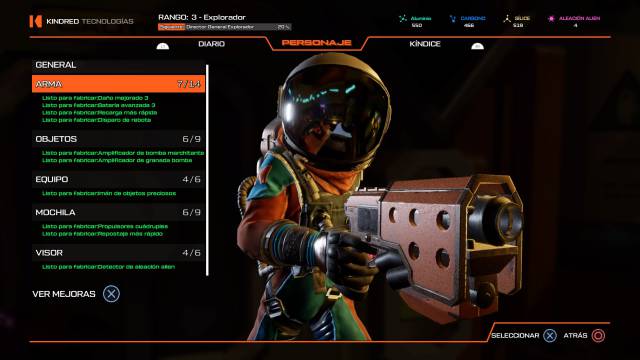
And it is that part of the success of Savage Planet lies in its ability not to overdo it on virtually nothing, not even the duration. A standard game can be around 10 hours, enough to complete the mission without too many detours, but appreciating the world and its possibilities. Then, those who want more, can continue exploring and exceed 15 hours without the game deflating in the process. And finally, if we feel like immersing ourselves in the charms of the speed run, it also proves to be well tuned (in fact it includes an achievement, easily assumed, that challenges to get off at 4 hours). The bosses, on the other hand, decorate the development with differentiated designs and competent combats – even a demanding point, which doesn't surprise you if you ever die. Although due to this they can be scarce, and at the end of the road it costs not to fantasize about a version of the game where there was at least one or two more.
It is the counterpart to the above, a symptom that sometimes it may be moderated to the defect. There is nothing intrinsically bad in combat, platform, puzzles or exploration, but it is also almost impossible to point out something groundbreaking, that crosses previously established limits or remains as a lesson for those who come in the future. That, obviously, can be interpreted as its own virtue, especially when working with elements and inspirations that the industry does not exploit so often. The result, although not deep, is still a fresh game, which will not transcend its influences, but it does combine them to create something solid and coherent, without fissures of mention – except for some errors in an otherwise fantastic location – and well defined thanks to its aesthetic and delirious humor. Like the Grob we use as bait, Savage Planet can know a thousand things or a specific one, but it is hard to resist one more ration when they put it in front of us.
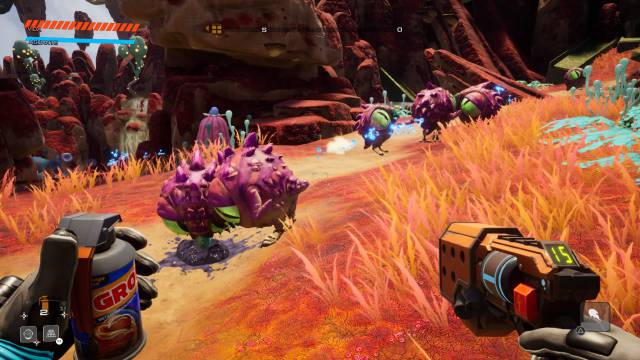
CONCLUSION
Whether by direct inspiration or by effects of cultural osmosis, Typhoon Studios' opera is loaded with family ideas, but also with a contagious energy that makes your proposal personal and interesting. Stranded on an alien planet, our goal is to collect materials, make improvements, make our way using a varied repertoire of tools and also hit shots when third. Of course, for better or worse, he decides not to go too deep into anything concrete. His commitment is with adventure and humor, and luckily he is a fruitful one. It is possible that in December we will not include it in the traditional debates about the best of the year, especially with the promises offered by this, but it is a great warming and leaves many moments that surely end up counting among the funniest of 2020 Rebel in tone, efficient in design, Journey to the Savage Planet does not belong to that kind of games that change the environment, but it definitely falls among those that are a real delight to play.
THE BEST
- An artistic section full of color and personality.
- The sense of humor, acid and surreal.
- Your cocktail of ideas is set in a solid and varied experience.
- Light rhythm, but abundant useful life of secondary schools.
WORST
- He plays several sticks correctly, but does not delve deeply into them.
- Having another boss would have given the adventure more packaging.
Very good
Remarkable game that we will enjoy and remember. A good purchase, highly recommended for lovers of the genre. It is well taken care of at all levels.
